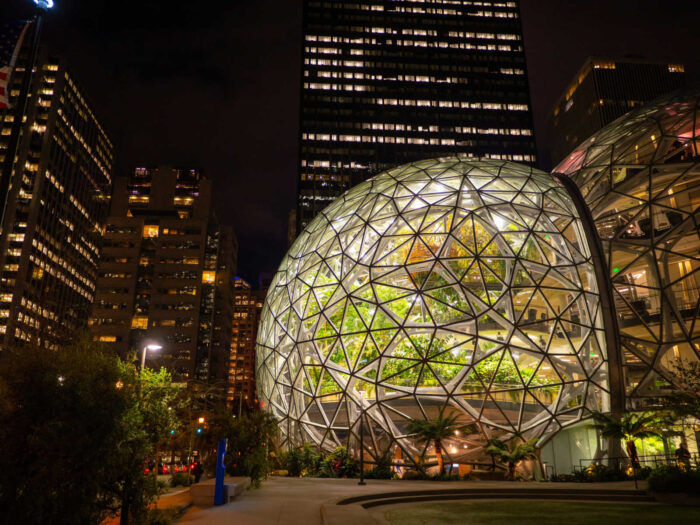
Amazon’s organizational structure enables top-down control in global operations. This corporate structure establishes the system of interactions among personnel, offices, divisions, departments, and resources for artificial intelligence, cloud computing, entertainment, consumer goods, consumer electronics, retail, and other business operations.
This business structure helps withstand retail and e-commerce competitors, like Walmart, eBay, Home Depot, Aldi, and Costco, as well as IT and consumer electronics firms, like Apple, Google (Alphabet), Microsoft, and Samsung.
Moreover, Amazon’s company structure supports competitiveness against entertainment content producers and distributors, like Netflix, Disney, Sony, and Facebook (Meta Platforms). The industry influence of IBM, and Intel is also managed through appropriate divisions of Amazon’s company structure.
These firms necessitate a business structure that addresses the diverse competition examined in the Five Forces analysis of Amazon. The company’s organizational structure facilitates strategic implementations that strengthen business competencies.
Amazon’s organizational structure supports managerial control for congruence in strategic management in multiple industries and various markets. Through this congruence, the business structure contributes to the strengths detailed in the SWOT analysis of Amazon.
The design of this organizational structure helps in fulfilling strategic goals based on Amazon’s corporate mission statement and corporate vision statement. For example, this company structure includes appropriate offices and divisions for ensuring the success of new IT and e-commerce products that meet customers’ preferences.
Primary Features of Amazon’s Organizational Structure
Amazon’s structure has matrix characteristics that indicate an organizational design matching diverse business needs in various industries and markets. The following are the primary features of Amazon’s organizational structure:
- Global hierarchical structure
- Function-based departments
- Operating segments
- Product-based divisions
- Geographic divisions
Departments, divisions, groups, and teams in Amazon’s organizational structure, corresponding to the features listed above, intersect in various ways for coordinated operations. Such intersections unify the company’s development toward its long-term goals.
These features of Amazon’s company structure influence the results of corporate management decisions, strategies, and control. For example, the geographic divisions of this company structure facilitate corporate strategies for regional online retail markets.
Amazon’s Global Hierarchical Structure
Hierarchy is a traditional organizational structural characteristic applied in Amazon’s organizational design. This hierarchical structure is expressed in terms of a system of vertical lines of command and authority influencing the technology and services business.
For example, senior executives’ directives are passed down from the headquarters through the company structure to lower-level managers in online retail services, inventory and warehouse management, and other business areas. These directives are then applied throughout the business organization, affecting all relevant offices and operations of Amazon.
A strategic objective linked to this feature of Amazon’s organizational structure is to facilitate managerial control of the organization. Through the corporate hierarchy, the company ensures executive control of IT and other operations throughout the multinational business organization.
The effectiveness of this corporate structure’s divisions, departments, groups, and teams requires human resource support for vertical lines of command in online and brick-and-mortar operations. Amazon’s organizational culture (work culture) promotes workplace behaviors for such human resource support for this business structure.
Function-Based Departments in Amazon’s Company Structure
Amazon has departments based on business functions, which are essential components of the organization. The following are some of the main function-based departments in Amazon’s organizational structure:
- Office of the President and CEO
- Operations
- Finance
- Human Resources
- Corporate and Business Development
- Communications and Corporate Responsibility
- Legal
Function-based departments are a basic characteristic of Amazon’s organizational structure. Each major business function, such as finance and human resource management, has a dedicated group or team, as well as a senior manager.
This organizational structure reflects traditional organizational design that focuses on basic business functions relevant to information technology, consumer goods, health care, retail, and related operations.
These departments of the company structure also directly address major business concerns. For example, the Communications and Corporate Responsibility department deals with Amazon’s stakeholder management and programs for CSR and ESG goals.
A strategic objective in having this structural characteristic is business effectiveness throughout the organization. Function-based departments in this company structure affect resource availability for effective operations, such as in consumer electronics design and development.
As another example, with this feature of the corporate structure, the Corporate and Business Development department and the Finance department coordinate to support business growth in establishing new market operations, as described in Amazon’s generic competitive strategy and intensive growth strategies.

Amazon’s Operating Segments
In its financial statements, Amazon specifies that its business structure involves three operating segments for business management and evaluation. The following are Amazon’s main business segments:
- North America
- International
- Amazon Web Services (AWS)
In Amazon’s company structure, these segments represent how operations are managed and assessed according to strategic objectives. The organizational structure shapes Amazon’s operations management through these segments, especially in grouping objectives and strategies for operations.
These segments are based on a product division and geographic divisions that require Amazon’s top-level executive management. With such segments, this organizational structure reflects the significance of AWS in the business.
Product-Based Divisions in Amazon’s Organizational Structure
Amazon has diverse operations and products in multiple industries and markets, but some of these operations and products stand out for their business and strategic significance. The following are the major product-based divisions in Amazon’s organizational structure:
- Amazon Web Services
- Worldwide Amazon Stores
- Zoox
There are other product-based divisions in Amazon’s business structure. However, the three enumerated above are the ones that are most notable in terms of top-level management at the company’s headquarters.
Each of these major product-based divisions has a CEO, which is an indicator of their significance in Amazon’s organizational structure and multinational business development strategies.
Other product-based divisions in this organizational structure include, but are not limited to, Amazon Health Services, Devices & Services, and Amazon Video and Studios. Product-based divisions may be added as the company acquires other firms or develops new products.
Amazon’s Geographic Divisions
Amazon groups operations according to geographic regions, with consideration for market similarities and relative revenues. These divisions correspond to the company’s operating segments. The following are the geographic divisions in Amazon’s organizational structure:
- North America
- International
This organizational structure involves geographical divisions representing target markets for Amazon’s international business. In this structural characteristic, divisions are based on geographical regions and related business goals for retail, Internet-based services, consumer electronics, and other operations.
These geographic divisions of the corporate structure facilitate the company’s management of the effects of the regional trends, opportunities, and threats described in the PESTEL/PESTLE analysis of Amazon.
In this regard, appropriate strategies implemented via this organizational structure address regional trends relevant to the success of the company’s goods and online and brick-and-mortar services.
These geographic divisions of the business structure influence how strategies and tactics are implemented in Amazon’s marketing mix (4Ps). Thus, this aspect of the organizational design determines the success of marketing strategies and plans for providing goods and services.
Advantages & Disadvantages of Amazon’s Company Structure
Amazon’s organizational structure supports business growth in the international market. The e-commerce company’s success in expanding its business is an indicator of the suitability of this corporate structure.
An advantage of function-based departments and the hierarchical structure is that they enable rapid and effective implementation of managerial directives and strategies from Amazon’s corporate headquarters.
Also, this organizational structure’s geographic divisions are advantageous in terms of ensuring that Amazon’s online and brick-and-mortar operations address the socioeconomic conditions of regional markets.
Amazon’s organizational structure supports the company’s complementary operations with subsidiaries, such as Whole Foods Market. Also, Amazon’s structure adapts to enterprise diversification involving further acquisitions.
A disadvantage of Amazon’s organizational structure is the potential for limitations in flexibility and responsiveness. The dominance of the global hierarchy could limit the company’s capacity to rapidly respond to new or emerging issues and problems.
References
- Amazon.com, Inc. – Corporate Offices.
- Amazon.com, Inc. – Form 10-K.
- Amazon.com, Inc. – Officers and Directors.
- Tsai-Lin, T. F., Chen, M. H., Chi, H. R., & Chiang, P. S. (2025). The impact of R&D organizational structure on developing technological capabilities and the moderation of R&D slack. Journal of Organizational Change Management, 38(1), 158-181.
- U.S. Department of Commerce – International Trade Administration – Retail Trade Industry.
- U.S. Department of Commerce – International Trade Administration – Software and Information Technology Industry.
- Wyland, R., Hanson-Rasmussen, N., & Clark, F. (2024). The structure-culture alignment activity: Aligning organizational structure elements with diversity, equity, and inclusion cultural values. Journal of Management Education, 48(1), 141-167.